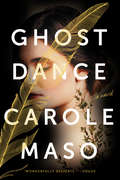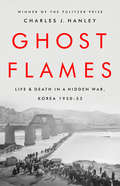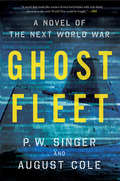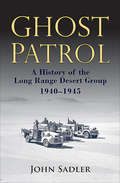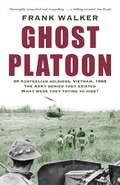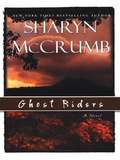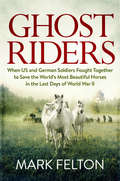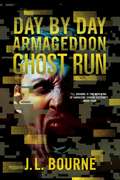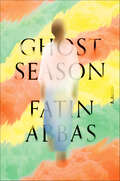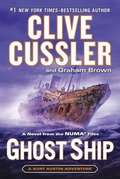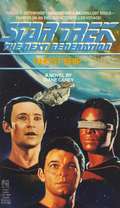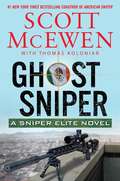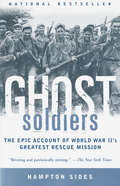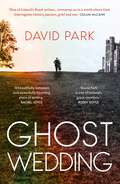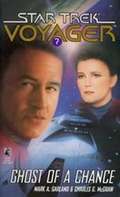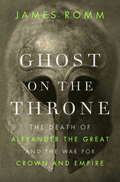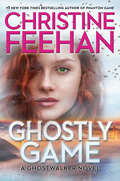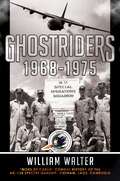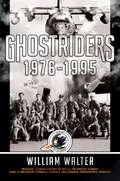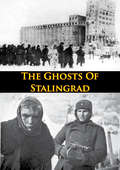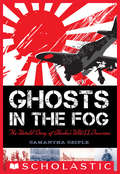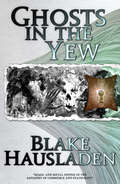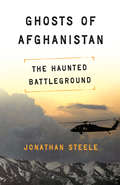- Table View
- List View
Ghost Dance: A Novel
by Carole Maso"Although author Carole Maso follows the contours of fiction, style is everything in Ghost Dance, a strangely lovely and perplexing book . . . she has a fine ear and her literary gift is impressive." —San Francisco ChronicleOriginally published in 1986, Ghost Dance is the first in a line of relentlessly experimental and highly esteemed works by Carole Maso.Vanessa Turin's family has been broken up by an event so devastating she cannot bear to face it straight on. Her mother, the brilliant and beautiful poet Christine Wing, seems simply to have disappeared, and her gentle, silent father also vanishes. In Ghost Dance, the reader experiences firsthand the dimensions of Vanessa's longing, the capabilities of her imagination, the persistence of her memory, and the ferocity of her love as she struggles to retrieve her family, to reclaim her country, and to come to terms with overwhelming sorrow.
Ghost Flames: Life and Death in a Hidden War, Korea 1950-1953
by Charles J. HanleyA powerful, character-driven narrative of the Korean War from the Pulitzer Prize-winning writer who helped uncover some of its longest-held and darkest secretsThe war that broke out in Korea on a Sunday morning 70 years ago has come to be recognized as a critical turning point in modern history, as the first great clash of arms of the Cold War, the last conflict between superpowers, and the root of a nuclear crisis that grips the world to this day.In this vivid, emotionally compelling and highly original account, Charles J. Hanley tells the story of the Korean War through the eyes of 20 individuals who lived through it--from a North Korean refugee girl to an American nun, a Chinese general to a black American prisoner of war, a British journalist to a US Marine hero.This is an intimate, deeper kind of history, whose meticulous research and rich detail, drawing on recently unearthed materials and eyewitness accounts, brings the true face of the Korean War, the vastness of its human tragedy, into a sharper focus than ever before. The "Forgotten War" becomes unforgettable.In decades as an international journalist, Hanley reported from some 100 countries and covered more than a half-dozen conflicts, from Vietnam to Afghanistan and Iraq.
Ghost Fleet: A Novel of the Next World War
by P. W. Singer August Cole"A novel that reads like science fiction but bristles with rich detail about how the next World War could be fought." --Vice"A modern-day successor to tomes such as The Hunt for Red October from the late Tom Clancy." --USA Today What Will World War III Look Like? Ghost Fleet is a page-turning imagining of a war set in the not-too-distant future. Navy captains battle through a modern-day Pearl Harbor; fighter pilots duel with stealthy drones; teenage hackers fight in digital playgrounds; Silicon Valley billionaires mobilize for cyber-war; and a serial killer carries out her own vendetta. Ultimately, victory will depend on who can best blend the lessons of the past with the weapons of the future. But what makes the story even more notable is that every trend and technology in book--no matter how sci-fi it may seem--is real. The debut novel by two leading experts on the cutting edge of national security, Ghost Fleet has drawn praise as a new kind of technothriller while also becoming the new "must-read" for military leaders around the world. "A wild book, a real page-turner." --The Economist "Ghost Fleet is a thrilling trip through a terrifyingly plausible tomorrow. This is not just an excellent book, but an excellent book by those who know what they are talking about. Prepare to lose some sleep."--D. B. Weiss, writer of HBO's Game of Thrones "It's exciting, but it's terrifying at the same time."--General Robert Neller, commandant of the U.S. Marine Corps
Ghost Patrol: A History of the Long Range Desert Group, 1940-1945
by John SadlerFrom the author of D-Day: “an amazing tale of how the world’s very first special force was created specifically for North Africa during WWII” (Books Monthly).The origins of most of the West’s Special Forces can be traced back to the Long Range Desert Group, which operated across the limitless expanses of the Libyan Desert, an area the size of India, during the whole of the Desert War from 1940 to 1943. After the defeat of the Axis in North Africa, they adapted to serve in the Mediterranean, the Greek islands, Albania, Yugoslavia, and Greece. In the process, they became the stuff of legend.The brainchild of Ralph Bagnold, a prewar desert explorer featured in fictional terms in The English Patient, the LRDG used specially adapted vehicles and recruited only men of the right temperament and high levels of fitness and endurance. Their work was often dangerous, always taxing, exhausting, and uncomfortable. They were a new breed of soldier, and the Axis never managed to field a similar unit.Once the desert war was won, they transferred their skills to the Mediterranean sector, retraining as mountain guerrillas, serving in the ill-fated Dodecanese campaign, then in strife-torn Albania, Yugoslavia, and Greece, fighting alongside the mercurial partisans. In addition, the LRDG worked alongside the fledgling SAS and established, beyond all doubt, the value of highly trained Special Forces, a legacy which resonates today.“Genuinely gripping, a tale of eccentrics and their high adventures during very dangerous times.” —Classic Military Vehicle
Ghost Platoon
by Frank Walker'thoroughly researched and compelling . . . a chilling account' - The Sun HeraldAn eye-opening account of Australian combat history, untold . . . until now.In 1969 a ragtag unit of 39 men were thrown together at Nui Dat, Vietnam. It was so slapdash a group it didn't even have an officer or sergeant in charge. A rugged ex-Royal Marine stepped forward to take the lead. Jim Riddle was only an acting corporal but he knew enough of war to keep these young diggers alive.When the platoon was involved in a high-risk ambush Riddle proved his leadership skills, bringing his men through unscathed and leaving the battlefield littered with enemy bodies.Despite their success, immediately afterwards the platoon was disbanded. According to the army they'd never existed ? theirs was a ghost platoon.Frank Walker details what happened at that ambush and why the army buried their existence, and the secrets that went with it. His findings are a shocking indictment of the long-term effects of war. The men of the platoon ? who'd fought so hard for their country ? had to fight again to reveal the truth. But the price they all paid was far too high.Ghost Platoon is a gripping story of the soldiers who should never be forgotten . . . or denied.
Ghost Riders
by Sharyn MccrumbThis novel tells the story of the Civil War in the Appalachians, based on actual events, where neighbors became enemies, and the half-life of violence keeps soldiers' ghosts abroad in the modern wilderness.
Ghost Riders: When US and German Soldiers Fought Together to Save the World's Most Beautiful Horses in the Last Days of World War II
by Mark FeltonIt is April 1945 and the world's most prized horses are about to be slaughtered...As the Red Army closes in on the Third Reich, a German colonel sends an American intelligence officer an unusual report about a POW camp soon to be overrun by the Soviets. Locked up, the report says, are over a thousand horses, including the entire herd of white Lipizzaner's from Vienna's Spanish Riding School, as well as Europe's finest Arabian stallions--stolen to create an equine "master race." The horses are worth millions and, if the starving Red Army reaches the stables first, they will kill the horses for rations. The Americans, under the command of General George Patton, whose love of horses was legendary, decide to help the Germans save the majestic creatures. So begins "Operation Cowboy," as GIs join forces with surrendered German soldiers and liberated prisoners of war to save the world's finest horses from fanatical SS soldiers and the ruthless Red Army in an extraordinary battle during the last few days of the war in Europe. This is an epic untold story from the waning days of World War II.Drawing from newly unearthed archival material, family archives held by descendants of the participants, and interviews with many of the participants published throughout the years, Ghost Riders is the definitive account of this truly unprecedented and moving story of kindness and compassion at the close of humanity's darkest hour.
Ghost Run (Day by Day Armageddon #4)
by J. L. BourneThe acclaimed and eagerly anticipated fourth thriller in the zombie apocalypse series from the author of Day by Day Armageddon and Day by Day Armageddon: Beyond Exile, for fans of the smash hit show The Walking Dead.In a desperate bid to survive as hordes of bloodthirsty undead now dominate the ravaged U.S. population, a Navy commander discovers an incredible secret about the pandemic in this fourth novel in the acclaimed Day by Day Armageddon series. Task Force Phoenix may be humanity's final hope, and the narrator's agonizing decisions could mean living one more day--or surrendering to the eternal hell that exists between life and death. Ghost Run is a suspenseful, gripping, and intelligent thriller that will terrify die-hard horror fans and reinforce J.L. Bourne's reputation as "the new king of hardcore zombie action" (Brad Thor, author of Act of War).
Ghost Season: A Novel
by Fatin AbbasA dynamic, beautifully orchestrated debut novel connecting five characters caught in the crosshairs of conflict on the Sudanese border.A mysterious burnt corpse appears one morning in Saraaya, a remote border town between northern and southern Sudan. For five strangers on an NGO compound, the discovery foreshadows trouble to come. South Sudanese translator William connects the corpse to the sudden disappearance of cook Layla, a northern nomad with whom he’s fallen in love. Meanwhile, Sudanese American filmmaker Dena struggles to connect to her unfamiliar homeland, and white midwestern aid worker Alex finds his plans thwarted by a changing climate and looming civil war. Dancing between the adults is Mustafa, a clever, endearing twelve-year-old, whose schemes to rise out of poverty set off cataclysmic events on the compound.Amid the paradoxes of identity, art, humanitarian aid, and a territory riven by conflict, William, Layla, Dena, Alex, and Mustafa must forge bonds stronger than blood or identity. Weaving a sweeping history of the breakup of Sudan into the lives of these captivating characters, Fatin Abbas explores the porous and perilous nature of borders—whether they be national, ethnic, or religious—and the profound consequences for those who cross them. Ghost Season is a gripping, vivid debut that announces Abbas as a powerful new voice in fiction.
Ghost Ship (NUMA Files #12)
by Clive Cussler Graham BrownThe dazzling new novel in the #1 New York Times-bestselling series from Clive Cussler, the grand master of adventure.<P> When Kurt Austin is injured attempting to rescue the passengers and crew from a sinking yacht, he wakes with fragmented and conflicted memories. Did he see an old friend and her children drown, or was the yacht abandoned when he came aboard? For reasons he cannot explain, Kurt doesn't trust either version of his recollection.<P> Determined to know the truth, he begins to search for answers, and soon finds himself descending into a shadowy world of state-sponsored cybercrime, and uncovering a pattern of vanishing scientists, suspicious accidents, and a web of human trafficking. With the help of Joe Zavala, he takes on the sinister organization at the heart of this web, facing off with them in locations ranging from Monaco to North Korea to the rugged coasts of Madagascar. But where he will ultimately end up¾even he could not begin to guess.
Ghost Ship (Star Trek: The Next Generation #1)
by Diane CareyAn original novel based on the acclaimed Star Trek TV series! In 1995, a Russian aircraft carrier is destroyed by a mysterious creature that just as mysteriously disappears thereafter. Three hundred years later, Counsellor Deanna Troi awakens in her quarters from a nightmare in which she senses the voices of the crew of that Russian ship, whose life-essences were somehow absorbed by the creature that destroyed them. And the nightmare heralds a danger to the Enterprise itself, for if Picard can't discover a way to communicate with the creature, it could absorb his crew just as it did the Russians.
Ghost Sniper: A Sniper Elite Novel (Sniper Elite #4)
by Thomas Koloniar Scott McEwenA top-secret band of elite warriors are forced to take a side in the Mexican drug wars in this “gripping, fast-paced adventure” (Dan Hampton, New York Times bestselling author of Viper Pilot) of the Sniper Elite series from the co-author of the #1 New York Times bestseller American Sniper.Bob Pope, the director of an American secret intelligence antiterrorism program, has lost contact with his most trusted operative, Navy Master Chief Gil Shannon, fearing him dead when a mission to take out a Swiss banker channeling funds to Muslim extremists goes awry. Now an American politician and her team have been assassinated in Mexico City by the Ghost Sniper—an American ex-military gunman-for-hire employed by Mexico’s most ruthless drug cartel—and Pope must turn instead to retired Navy SEAL Daniel Crosswhite and brand-new Sniper Elite hero, ex–Green Beret Chance Vaught, in order to track down the Ghost Sniper and expose the corrupt officials behind this murderous international plot!
Ghost Soldiers: The Epic Account of World War II's Greatest Rescue Mission
by Hampton SidesNATIONAL BESTSELLER • &“The greatest World War II story never told&” (Esquire)—an enthralling account of the heroic mission to rescue the last survivors of the Bataan Death March—from the author of Blood and Thunder. On January 28, 1945, 121 hand-selected U.S. troops slipped behind enemy lines in the Philippines. Their mission: March thirty rugged miles to rescue 513 POWs languishing in a hellish camp, among them the last survivors of the infamous Bataan Death March. A recent prison massacre by Japanese soldiers elsewhere in the Philippines made the stakes impossibly high and left little time to plan the complex operation. In Ghost Soldiers Hampton Sides vividly re-creates this daring raid, offering a minute-by-minute narration that unfolds alongside intimate portraits of the prisoners and their lives in the camp. Sides shows how the POWs banded together to survive, defying the Japanese authorities even as they endured starvation, tropical diseases, and torture. Harrowing, poignant, and inspiring, Ghost Soldiers is the mesmerizing story of a remarkable mission. It is also a testament to the human spirit, an account of enormous bravery and self-sacrifice amid the most trying conditions.
Ghost Target (Ryan Drake)
by Will JordanIn this action-packed international thriller, a British Army veteran turned government operative must take down a rogue CIA agent. From Marseille to Islamabad at breakneck pace, it&’s kill or be killed . . . Ryan Drake—once a decorated field operative—is wanted for treason. On the run from the corrupt CIA Deputy Director Marcus Cain, he has settled in a remote French safehouse. His uneasy peace is soon shattered by a startling force. Meanwhile, with the war in Afghanistan faltering, the ambitious Cain claims to have a plan to destroy al-Qaeda&’s top commanders. And nobody will stand in his way. Backed into a corner, and suspecting Cain&’s motives, Drake turns to the deadly but unpredictable Anya—once Cain&’s protégé, now his most bitter enemy. With the fate of the War on Terror potentially hanging in the balance, Drake and a hastily assembled team travel to Pakistan to intercept Cain. As loyalties are tested and scores are settled, only one side will survive . . . An action-packed tale of desperation and betrayal, Ghost Target is ideal for fans of Tom Clancy and Vince Flynn. Praise for the Ryan Drake series: &“Entertaining.&” —The Daily Telegraph &“A heart-stopper for anyone who likes plenty of action and explosions.&” —Daily Mail
Ghost Wedding
by David ParkA POIGNANT STORY OF LOVE AND REGRET, FROM A MASTER OF CONTEMPORARY IRISH FICTION * 'David Park is one of Ireland's great novelists.' Roddy Doyle, author of The Commitments * For fans of Sebastian Faulks, Donal Ryan and Anne Tyler comes this beautiful novel following two troubled men, separated by nearly a century, bound by the ghosts of their past When George Allenby is put in charge of building a lake in the grounds of an imposing Irish manor house, he intends to do the job as swiftly as possible and return to Belfast. Allenby is still wrestling with his time as an officer during the First World War, burdened by the many things he could have done differently. Almost a century later, Alex and Ellie are preparing for their wedding, sparing no expense to hire a venue overlooking the very lake Allenby built all those years ago. Like Allenby before him, Alex is haunted by decisions he made in the past. Now, with the wedding drawing ever closer, he is at a crossroads. Telling the truth might free him from his guilt; it might also take away everything he cares about, including Ellie. In this masterful portrait of love and betrayal, David Park reveals the many ways the past seeps into the present: destructive, formidable, but also hopeful, in the moments of fragile beauty that remain.
Ghost of a Chance (Star Trek: Voyager #7)
by Mark Garland Charles G. McGrawWhen an alien ship offers aid to both a damaged Voyager and a planet in peril, the crew members of the Voyager must decide whether or not to take their questionable offer.Badly damaged in a close encounter with a dwarf star, the Voyager discovers a planet being torn apart by tremendous volcanic stresses. The planet's primitive inhabitants will surely perish unless the Voyager intervenes—but the Prime Directive forbids them to act. And then the dilemma is increased by the arrival of another starship, a Televek vessel, whose crew offer to help both the Voyager and the people of the crumbling planet. But Janeway senses something amiss with their saviors, and she's haunted by ghostly visions warning her of a threat that make her loathe to accept anything from the Televek, even though they may be her only hope.
Ghost on the Throne: The Death of Alexander the Great and the Bloody Fight for His Empire
by James RommAlexander the Great, perhaps the most commanding leader in history, united his empire and his army by the titanic force of his will. His death at the age of thirty-two spelled the end of that unity.The story of Alexander's conquest of the Persian empire is known to many readers, but the dramatic and consequential saga of the empire's collapse remains virtually untold. It is a tale of loss that begins with the greatest loss of all, the death of the Macedonian king who had held the empire together. With his demise, it was as if the sun had disappeared from the solar system, as if planets and moons began to spin crazily in new directions, crashing into one another with unimaginable force.Alexander bequeathed his power, legend has it, "to the strongest," leaving behind a mentally damaged half brother and a posthumously born son as his only heirs. In a strange compromise, both figures--Philip III and Alexander IV--were elevated to the kingship, quickly becoming prizes, pawns, fought over by a half-dozen Macedonian generals. Each successor could confer legitimacy on whichever general controlled him.At the book's center is the monarch's most vigorous defender; Alexander's former Greek secretary, now transformed into a general himself. He was a man both fascinating and entertaining, a man full of tricks and connivances, like the enthroned ghost of Alexander that gives the book its title, and becomes the determining factor in the precarious fortunes of the royal family.James Romm, brilliant classicist and storyteller, tells the galvanizing saga of the men who followed Alexander and found themselves incapable of preserving his empire. The result was the undoing of a world, formerly united in a single empire, now ripped apart into a nightmare of warring nation-states struggling for domination, the template of our own times.From the Hardcover edition.
Ghostly Game (A GhostWalker Novel #19)
by Christine FeehanIt&’s fight or flight in this sultry, suspenseful GhostWalker novel from #1 New York Times bestselling author Christine Feehan.Gideon &“Eagle&” Carpenter is used to rolling with the punches life has thrown at him. It&’s the only thing that&’s kept him alive. He and his team of GhostWalkers have seen and experienced it all. He does his best to live with all the sins written on his soul. Then he hears the laughter of a woman with the ability to erase—even for a few precious moments—the darkness of his past.Laurel &“Rory&” Chappel has always been a nomad. She&’s accustomed to taking care of herself, despite the physical challenges she lives with. She thinks she&’s too weak to find real love, but that doesn&’t stop her interest in Gideon from turning into a full-on addiction. He&’s all rough edges and danger contrasted with a tenderness that makes her feel safe. Still, after a life spent in motion, she&’s not sure she knows how to stay in one place.Gideon hopes he can persuade Rory to take a chance on him with every electric touch. But soon, life conspires against him, forcing the GhostWalker to risk everything to protect the woman he loves....
Ghostrider One
by Gerry CarrollCommander Jim "Hog" Hogan, U.S. Navy, has signed on for his second tour of duty in Vietnam, aboard the aircraft carrier U.S.S. Shiloh as executive officer of an A-4 Skyhawk attack squadron. The unit is in disarray, and it's up to Hogan to renew their confidence, for they're about to undertake a rescue mission that will test their skill and courage like never before. Deep in the highlands near the DMZ and Laos, Hogan's buddy, Marine aviator Major Dick Averitt, is trapped with his fellow marines in a little bit of hell on earth called Khe Sanh. The North Vietnamese Tet Offensive has begun, and there is but one hope for the Americans' survival: Operation Niagara. Through the screaming, tracer-streaked skies, Hogan's A-4 Skyhawks and the U.S.S. Shiloh's F-4 Phantoms must lay down a carpet of death surrounding the combat base. Plunging into the neat, the acrid smoke, and the ear-numbing roar of battle, Hoaan and his men move from terror to exhilaration and back again.
Ghostriders 1968-1975: "Mors De Caelis" Combat History of the AC-130 Spectre Gunship, Vietnam, Laos, Cambodia (Ghostriders #1)
by William WalterIf necessity is the mother of invention, the AC-130 gunship was definitely her offspring.Ghostriders: Mors De Caelis is a comprehensive history of AC-130 gunship combat operations in Vietnam, Laos, and Cambodia. The story begins with the first AC-130 in 1968, and ends in 1975 at the end of the war in Vietnam. It tells the life and death stories of Spectre crews, who faced extreme danger while hunting trucks on the Ho Chi Minh Trail and providing fire support for US and allied ground forces. Though the AC-130 was credited with 10,000 trucks destroyed, this phenomenal achievement came with a hefty price. Fifty-two Spectre crewmen and six AC-130s were lost during combat operations in Laos and Vietnam. Written in third-person omniscient point of view by an experienced combat veteran and Spectre Historian, all aspects of the story are derived from official declassified records and personal interviews. The level of detail and context figuratively puts the reader in the aircraft as an observer, flying alongside a Spectre crew in combat. Above all, this is the story of Spectre—accurate, detailed, compelling, and unique.
Ghostriders 1976-1995
by William WalterResistance is futile. You can run, but you&’ll only die tired.The AC-130 Gunship was quickly developed in 1968 to provide fire support for ground forces in Vietnam. Twenty-eight C-130 cargo aircraft were converted into AC-130s for night attack operations. The AC-130 was crude, ugly, ad hoc, and detested by many within the USAF…but it worked, and it worked well. Likewise, AC-130 crews were deemed unruly &“biker gangs,&” but performed magnificently in every major US military operation from 1976 to 1995. Most of these combat operations were cloaked in secrecy, but records once classified for up to twenty years have now been opened. Based on this newly declassified information and hundreds of interviews with SOF veterans, Ghostriders 1976-1995 is the first authoritative historical account of the AC-130 operations, written by an AC-130 Aerial Gunner who participated in every AC-130 combat operation from 1980 through 1994.
Ghosts Of Stalingrad
by Major Willard B. Atkins IIThe Battle of Stalingrad was a disaster. The German Sixth Army consisted of over 300,000 men when it approached Stalingrad in August 1942. On 2 February 1943, 91,000 remained; only some 5,000 survived Soviet captivity. Largely due to the success of previous aerial resupply operations, Luftwaffe leaders assured Hitler they could successfully supply the Sixth Army after it was trapped. However, the Luftwaffe was not up to the challenge. The primary reason was the weather, but organizational and structural flaws, as well as enemy actions, also contributed to their failure.This thesis will address why the Demyansk and Kholm airlifts convinced the Germans that airlift was a panacea for encircled forces; the lessons learned from these airlifts and how they were applied at Stalingrad; why Hitler ordered the Stalingrad airlift despite the logistical impossibility; and seek out lessons for today's military. The primary reason for the Stalingrad tragedy was that Germany's strategic leadership did not apply lessons learned from earlier airlifts to the Stalingrad airlift, and the U.S. military is making similar mistakes with respect to the way it is handling its lessons learned from recent military operations.
Ghosts in the Fog: The Untold Story of Alaska's WWII Invasion
by Samantha SeipleFew know the story of the Japanese invasion of Alaska during World War II--until now.GHOSTS IN THE FOG is the first narrative nonfiction book for young adults to tell the riveting story of how the Japanese invaded and occupied the Aleutian Islands in Alaska during World War II. This fascinating little-known piece of American history is told from the point of view of the American civilians who were captured and taken prisoner, along with the American and Japanese soldiers who fought in one of the bloodiest battles of hand-to-hand combat during the war. Complete with more than 80 photographs throughout and first person accounts of this extraordinary event, GHOSTS IN THE FOG is sure to become a must-read for anyone interested in World War II and a perfect tie-in for the 70th anniversary of the bombing of Pearl Harbor.
Ghosts in the Yew (Vesteal Series #1)
by Blake HausladenI would recommend “Ghosts in the Yew” to everyone who likes an elaborate Fantasy story full of political intrigue with a splash of magic. Especially if you read “The Pillars of the Earth” and enjoyed it, this will be a great read for you!" – Draumr Kopa Fantasy Book BlogThe Vesteal Series has sold over five thousand hardcover copies through hard-earned convention handsales. Now, the story is moving into the digital age with cover art by Hugo award-winning artist, Elizabeth Leggett.Ghosts in the Yew is a page-turning epic fantasy about a country on the brink of war, surrounded by the mysteries of ancient gods, blood magic, and statecraft. This is the story of four souls that are banished beyond the edge of the map. Redemption, conquest, and intrigue ignite the journey with love, honor, and a crown at stake. Their struggles to survive will put them at odds with their families, their nation, and the very powers that shaped the world. But, this story is bigger than these things.It’s bigger than all of us."Like spanish moss or ivy, Ghosts in the Yew grows slowly at first but before you know it you are enveloped into a world with so much beauty and terror that it deserves to be read with an attention to the detail that the author has so carefully written." – Stephen, Goodreads"I found it just a little too easy to get lost in the story that Ghosts in the Yew was telling, which to me, is one of the greatest signs of a good story and author.” – The Arched DoorwayThe Vestal Series1. Ghosts in the Yew Novella 1 - Beyond the Edge Novella 2 - Opposing Oaths Novella 3 - Reckless Borders Novella 4 - Bayen's Women Novella 5 - Falling Tides2. Native Silver Novella 1 - Sutler's Road Novella 2 - Forgotten Stairs Novella 3 - Thrall's Wine Novella 4 - Corsair Princess Novella 5 - Tanayon Born 3. The Vastness Novella 1 - Silent Rebellion Novella 2 - The River War Novella 3 - The Blinded Novella 4 - Crimson Valley Novella 5 - Singer's Reward"Ghosts in the Yew is one of those gems that is a satisfying tale from start to finish, and deep enough to withstand multiple readings. If you yearn for adventure, swordplay, justice, and romance in one story, do not even hesitate before plucking this one up and diving in feet first." – Ophelia, Goodreads
Ghosts of Afghanistan: The Haunted Battleground
by Jonathan SteeleA masterful blend of graphic reporting, illuminating interviews, and insightful analysis. Ghosts of Afghanistan is the first account of Afghanistan's turbulent recent history by an independent eyewitness.Jonathan Steele, an award-winning journalist and commentator, has covered the country since his first visit there as a reporter in 1981. He tracked the Soviet occupation and the communist regime of Najibullah, which held the Western-backed resistance at bay for three years after the Soviets left. He covered the arrival of the Taliban to power in Kabul in 1996, and their retreat from Kandahar under the weight of U.S. bombing in 2001. Most recently Steele has reported from the epicenter of the Taliban resurgence in Helmand.Ghosts of Afghanistan turns a spotlight on the numerous myths about Afghanistan that have bedeviled foreign policy-makers and driven them to repeat earlier mistakes. Steele has conducted numerous interviews with ordinary Afghans, two of the country's Communist presidents, senior Soviet occupation officials, as well as Taliban leaders, Western diplomats, NATO advisers, and United Nations negotiators.Comparing the challenges facing the Obama Administration as it seeks to find an exit strategy with those the Kremlin faced in the 1980s, Steele cautions that military victory will elude the West just as it eluded the Kremlin. Showing how and why Soviet efforts to negotiate an end to the war came to nothing, he explains how negotiations today could put a stop to the tragedies of civil war and foreign intervention that have afflicted Afghanistan for three decades.
